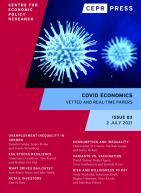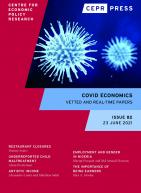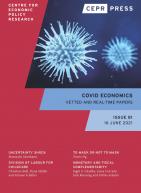
We study how the differential timing of local lockdowns due to COVID-19 causally affects households’ spending and macroeconomic expectations at the local level using several waves of a customized survey with more than 10,000 respondents. About 50% of survey participants report income and wealth losses due to the corona virus, with the average losses being $5,293 and $33,482 respectively. Aggregate consumer spending dropped by 31 log percentage points with the largest drops in travel and clothing. We find that households living in counties that went into lockdown earlier expect the unemployment rate over the next twelve months to be 13 percentage points higher and continue to expect higher unemployment at horizons of three to five years. They also expect lower future inflation, report higher uncertainty, expect lower mortgage rates for up to 10 years, and have moved out of foreign stocks into liquid forms of savings. The imposition of lockdowns can account for much of the decline in employment in recent months as well as declines in consumer spending. While lockdowns have pronounced effects on local economic conditions and households’ expectations, they have little impact on approval ratings of Congress, the Fed, or the Treasury but lead to declines in the approval of the President.
Citation
Gorodnichenko, Y, M Weber and O Coibion (2020), ‘The cost of the COVID-19 crisis: Lockdowns, macroeconomic expectations and cosumer spending‘, COVID Economics 20, CEPR Press, Paris & London. https://cepr.org/publications/covid-economics-issue-20#392514_392896_390463
In times of crisis, humans have a tendency to turn to religion for comfort and explanation. The 2020 COVID-19 pandemic is no exception. Using daily data on Google searches for 95 countries, this research demonstrates that the COVID-19 crisis has increased Google searches for prayer (relative to all Google searches) to the highest level ever recorded. More than half of the world population had prayed to
end the coronavirus. The rise amounts to 50% of the previous level of prayer searches or a quarter of the fall in Google searches for ights, which dropped dramatically due to the closure of most international air transport. Prayer searches rose at all levels of income, inequality, and insecurity, but not for the 10% least religious countries. The increase is not merely a substitute for services in the physical churches that closed down to limit the spread of the virus. Instead, the rise is due to an intensified demand for religion: We pray to cope with adversity.
Citation
Bentzen, J (2020), ‘In crisis, we pray: Religiosity and the Covid-19 pandemic‘, COVID Economics 20, CEPR Press, Paris & London. https://cepr.org/publications/covid-economics-issue-20#392514_392896_408764
This paper assesses the differential impacts on mental health of distinct public policy lockdown responses to the early part of the Covid-19 pandemic. It develops novel narrative economics of language approach born at the intersection of cultural economics, big data and narrative economic analysis. This approach is reliant on the study of language to extract cultural and behavioural insights with socioeconomic relevance. We sourced Google trend data for seed keywords, death and suicide, and employed difference-in-differences and regression discontinuity estimation techniques to conduct two investigations. First, we compared the amount of emotional distress experienced by British and Italian residents before and after the implementation of lockdown policies. Second, we extended our analysis to include a country that did not impose a lockdown, Sweden, as a control, which facilitated a natural quasi-experiment. Our main findings are that the lockdown policy affected public mental health, yet the dominant factor for public mental health was the cognitive bias of salient public death toll statistics. Countries had a pre-existing culturally relative disposition towards death-related anxiety, and the magnitude of their response to the pandemic varies in a cultural hysteresis manner. Searches for the keyword suicide decreased during the pandemic, while the interest in trivia remained unaffected, as indicated through searches for the keyword chair. Significant spillovers from one †specific national lockdown public policies to another country’s mental health are identified.
Citation
Tubadji, A, D Webber and F Boy (2020), ‘Narrative Economics, Public Policy and Mental Health‘, COVID Economics 20, CEPR Press, Paris & London. https://cepr.org/publications/covid-economics-issue-20#392514_392896_390464
Since the beginning of the COVID-19 crisis, our perception of the world significantly changed. In this paper we show the results of 3 studies that collectively illustrate a novel mechanism through which this has happened. We document the effect of social distancing on our perceptions, through the moderating effect of ambiguity aversion. In experiment 1 we show that ambiguity aversion predicts illusory pattern perception, defined as identifying faces in white noise pictures. In experiment 2 we show that ambiguity aversion also predicts higher cognitive level illusory pattern perception, defined as belief in conspiracy theories. Experiment 3 shows, through two uniquely timed questionnaires, that ambiguity aversion increases significantly from before to after the lockdown (due to the COVID-19 pandemic) for a sample of over 300 subjects. Remarkably, this difference in ambiguity aversion is no longer significant when we control for the drop in regular social contact over this period.
Citation
Van den Hurk, J and G Piccillo (2020), ‘The surprising effect of social distancing on our perception: coping with uncertainty‘, COVID Economics 20, CEPR Press, Paris & London. https://cepr.org/publications/covid-economics-issue-20#392514_392896_390465
We measure labor demand and supply shocks at the sector level around the Covid-19 outbreak, by estimating a Bayesian structural vector autoregression on monthly statistics of hours worked and real wages and applying the methodology proposed by Baumeister and Hamilton (2015). Our estimates suggest that two-thirds of the 16.24 percentage point drop in the growth rate of hours worked in April 2020 are attributable to supply. Most sectors were subject to historically large negative labor supply and demand shocks in March and April 2020, but there is substantial heterogeneity in the size of these shocks across sectors. Leisure and Hospitality was particularly affected. We find positive labor demand shocks for sectors such as Retail Trade, and Information in March 2020 that vanish in April 2020. We show that our estimates of supply shocks are correlated with sectoral measures of telework.
Citation
Duarte, J, M Faria e castro and P Brinca (2020), ‘Measuring Sectoral Supply and Demand Shocks during COVID-19‘, COVID Economics 20, CEPR Press, Paris & London. https://cepr.org/publications/covid-economics-issue-20#392514_392896_390466


Covid Economics - Issue 82
- Restaurant Closures during the Pandemic: A Descriptive Analysis
- Underreporting Child Maltreatment during the Pandemic: Evidence from Colorado
- Covid-19 impact on Artistic Income
- COVID-19, Employment, and Gender: Evidence from Nigeria
- The Importance of Being Earners: Modelling the Implications of Changes to Welfare Contributions on Macroeconomic Recovery
